Chemical process accelerator systems utilizing taylor vortex flows
a technology of accelerator system and vortex flow, which is applied in the direction of physical/chemical process catalyst, gas-gas reaction process, cell components, etc., can solve the problems of significant improvement in fuel cell performance, inability to replicate the operating conditions of chemical reactor, and trade-off between transport-limited and surface-limited, so as to reduce the surface-limiting and transport-limiting characteristics of catalysts, reduce the effect of surface-limiting and surface-limiting of catalytic reactions
- Summary
- Abstract
- Description
- Claims
- Application Information
AI Technical Summary
Benefits of technology
Problems solved by technology
Method used
Image
Examples
Embodiment Construction
[0071]A chemical processor accelerator system 10 comprises two principal components; namely, Taylor Vortex Flows (TVF) that generate high-shear-rate laminar Circular Couette Flows (CCF) and catalysts. While these components cooperate to promote chemical reactions in a wide variety of chemical reactors, each will be described separately in an embodiment taught in Case B, which discloses a fuel reformer used to extract H2 from fuels. To assist the reader, element numbers of FIG. 1A and FIG. 1B used in the following description of the fuel reformer are the almost the same as those used in FIG. 5A and FIG. 5B of Case B.
[0072]FIG. 1A and FIG. 1B are cross-sectional views of portions of an external TVF fuel reformer 90 suitable for a) pyrolytic or b) steam or partial oxidation reforming of hydrocarbon fuels such as methane (CH4), methanol (CH3OH), ethanol (C2H5OH), propane (C3H8), butane (C4H10), octane (C8H18), kerosene (C12H26) and gasoline as well as other hydrogen-bearing chemicals su...
PUM
| Property | Measurement | Unit |
|---|---|---|
| Temperature | aaaaa | aaaaa |
| Mass | aaaaa | aaaaa |
Abstract
Description
Claims
Application Information
 Login to View More
Login to View More - R&D
- Intellectual Property
- Life Sciences
- Materials
- Tech Scout
- Unparalleled Data Quality
- Higher Quality Content
- 60% Fewer Hallucinations
Browse by: Latest US Patents, China's latest patents, Technical Efficacy Thesaurus, Application Domain, Technology Topic, Popular Technical Reports.
© 2025 PatSnap. All rights reserved.Legal|Privacy policy|Modern Slavery Act Transparency Statement|Sitemap|About US| Contact US: help@patsnap.com



